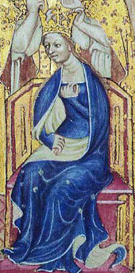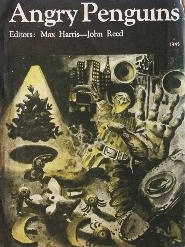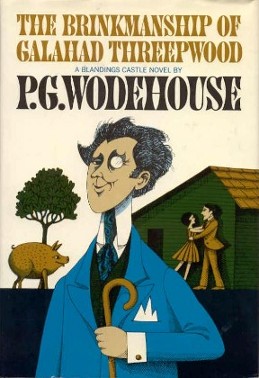
Sir Pelham Grenville Wodehouse, was an English writer and one of the most widely read humorists of the 20th century. His creations include the feather-brained Bertie Wooster and his sagacious valet, Jeeves; the immaculate and loquacious Psmith; Lord Emsworth and the Blandings Castle set; the Oldest Member, with stories about golf; and Mr. Mulliner, with tall tales on subjects ranging from bibulous bishops to megalomaniac movie moguls.

Berengaria of Navarre was Queen of England as the wife of Richard I of England. She was the eldest daughter of Sancho VI of Navarre and Sancha of Castile. As is the case with many of the medieval English queens, little is known of her life.

Anne of Bohemia, also known as Anne of Luxembourg, was Queen of England as the first wife of King Richard II. A member of the House of Luxembourg, she was the eldest daughter of Charles IV, Holy Roman Emperor and King of Bohemia, and Elizabeth of Pomerania. Her death at the age of 28 was believed to have been caused by plague.

In social psychology, propinquity is one of the main factors leading to interpersonal attraction.

Poets' Corner is a section of the southern transept of Westminster Abbey in London, where many poets, playwrights, and writers are buried or commemorated.
The conspiracy thriller is a subgenre of thriller fiction. The protagonists of conspiracy thrillers are often journalists or amateur investigators who find themselves pulling on a small thread which unravels a vast conspiracy that ultimately goes "all the way to the top." The complexities of historical fact are recast as a morality play in which bad people cause bad events, and good people identify and defeat them. Conspiracies are often played out as "man-in-peril" stories, or yield quest narratives similar to those found in whodunits and detective stories.

Catherine Helen Spence was a Scottish-born Australian author, teacher, journalist, politician, leading suffragist, and Georgist. Spence was also a minister of religion and social worker, and supporter of electoral proportional representation. In 1897 she became Australia's first female political candidate after standing (unsuccessfully) for the Federal Convention held in Adelaide. Called the "Greatest Australian Woman" by Miles Franklin and by the age of 80 dubbed the "Grand Old Woman of Australia", Spence was commemorated on the Australian five-dollar note issued for the Centenary of Federation of Australia.

The Da Vinci Code is a 2006 mystery thriller film directed by Ron Howard, written by Akiva Goldsman, and based on Dan Brown's 2003 novel of the same name. The first in the Robert Langdon film series, the film stars Tom Hanks, Audrey Tautou, Ian McKellen, Alfred Molina, Jürgen Prochnow, Jean Reno, and Paul Bettany. In the film, Robert Langdon, a professor of religious symbology from Harvard University, is the prime suspect in the grisly and unusual murder of Louvre curator Jacques Saunière. On the body, the police find a disconcerting cipher and start an investigation. Langdon escapes with the assistance of police cryptologist Sophie Neveu, and they begin a quest for the legendary Holy Grail. Sir Leigh Teabing, a noted British Grail historian, tells them that the actual Holy Grail is explicitly encoded in Leonardo da Vinci's wall painting The Last Supper. Also searching for the Grail is a secret cabal within Opus Dei, an actual prelature of the Holy See, who wish to keep the true Grail a secret to prevent the destruction of Christianity.

Angry Penguins was an art and literary journal founded in 1940 by surrealist poet Max Harris. Originally based in Adelaide, the journal moved to Melbourne in 1942 once Harris joined the Heide Circle, a group of modernist painters and writers who stayed at Heide, a property owned by art patrons John and Sunday Reed. Angry Penguins subsequently became associated with, and stimulated, an art movement now known by the same name. The Angry Penguins sought to introduce avant-garde ideas into Australian art and literature, and position Australia within a broader international modernism. Key figures of the movement include Sidney Nolan, Arthur Boyd, Joy Hester and Albert Tucker.

Galahad at Blandings is a novel by P. G. Wodehouse, first published in the United States on 31 December 1964 by Simon & Schuster, Inc., New York under the title The Brinkmanship of Galahad Threepwood, and in the United Kingdom on 26 August 1965 by Herbert Jenkins, London.

The Da Vinci Code is a 2003 mystery thriller novel by Dan Brown. It is Brown's second novel to include the character Robert Langdon: the first was his 2000 novel Angels & Demons. The Da Vinci Code follows symbologist Langdon and cryptologist Sophie Neveu after a murder in the Louvre Museum in Paris entangles them in a dispute between the Priory of Sion and Opus Dei over the possibility of Jesus and Mary Magdalene having had a child together.
Sir William Neil McKie was an Australian organist, conductor, and composer. He was Organist and Master of the Choristers at Westminster Abbey 1941–1963 and noted for his direction of the music for the marriage of Princess Elizabeth in 1947, and later her Coronation in 1953.
Susan Dorothea White is an Australian artist and author. She is a narrative artist and her work concerns the natural world and human situation, increasingly incorporating satire and irony to convey her concern for human rights and equality. She is the author of Draw Like da Vinci (2006).
Raikes Currie was Member of Parliament (MP) for Northampton from 1837 to 1857. He was a partner of the bank Curries & Co., which became part of Glyn, Mills & Co. in 1864, along with his father, Isaac Currie, in Cornhill, City of London, and had several interests in the newly developing colony of South Australia. He restored Minley Manor and made substantial improvements to the estate, work which was continued by his son and grandson.
George Edgar ‘Eddie’ Metcalf, Chinese name 王懷仁 Wáng Huáirén, was a British Protestant missionary serving in China with the China Inland Mission and credited with the first translation of the New Testament for the Eastern Lisu/Lipo minority.

John Harry Grainger was an Australian architect and civil engineer, who was also the father of musician Percy Grainger. Over his long career, between 1878 and 1915, he designed 14 bridges, notably Princes Bridge in Melbourne, and as an architect, designed half a dozen major public buildings, mainly in New Zealand, Perth, and Melbourne, notably the WA Supreme Court. He also designed some major commercial buildings in Melbourne such as Georges Store.
Struck Oil is an 1874 play set during the American Civil War and a 1919 Australian silent film, now considered lost. The play, which introduced Maggie Moore to Australian theatre-goers, was popular with the Australian public and the basis of J. C. Williamson's success as a theatre entrepreneur. A film based on the play and directed by Franklyn Barrett was produced in 1919.

Rev. Lord John Thynne was an English aristocrat and Anglican cleric, who served for 45 years as Deputy Dean of Westminster.
Come On, Jeeves is a comedic play co-written by Guy Bolton and P. G. Wodehouse. The play was written in the summer of 1952, and toured the English provinces in the summer of 1954. Wodehouse adapted the play into the novel Ring for Jeeves, which was first published in April 1953, a year before the play reached production. Come On, Jeeves is still occasionally produced and was presented as recently as December 2017.
Peter John Tregear OAM is an Australian musicologist, author and performer.












